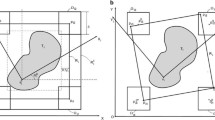Abstract
We study the Nesting Problem, which aims to determine a configuration of a set of irregular shapes within a rectangular sheet of material of fixed width, such that no overlap among the shapes exists, and such that the length of the sheet is minimized. When both translation and rotation of the shapes are allowed, the problem can be formulated as a nonconvex quadratically constrained programming model that approximates each shape by a set of inscribed circles and enforces that circle pairs stemming from different shapes do not overlap. However, despite many recent advances in today’s global optimization solvers, solving this nonconvex model to guaranteed optimality remains extremely challenging even for the state-of-the-art codes. In this paper, we propose a customized branch-and-bound approach to address the Nesting Problem to guaranteed optimality. Our approach utilizes a novel branching scheme to deal with the reverse convex quadratic constraints in the quadratic model and incorporates a number of problem-specific algorithmic tweaks. Our computational studies on a suite of 64 benchmark instances demonstrate the customized algorithm’s effectiveness and competitiveness over the use of general-purpose global optimization solvers, including for the first time the ability to find global optimal nestings featuring five polygons under free rotation.












Similar content being viewed by others

Notes
In fact, one needs only impose these constraints for the vertices that constitute the convex hull of polygon \(p \in P\).
We prefer to use \(h_p + v_p \le h_q + v_q\), because it is likely to break symmetry in more instances.
In the original implementation of Jones [14], the values 5 and 13 were proposed for parameter \(N^{\text {init}}\). However, in most instances used in this study, we found that using 5 or more circles per each and every polygon leads to initial QCP models that cannot be solved within the time limit, i.e., the GO solvers could not even complete the first (and also easiest) iteration. In contrast, using the setting \(N^{\text {init}}= 3\) and allowing the circle sets to grow more judiciously as overlaps are identified led to much better performance of the QP-Nest approach.
For the sake of better numerical stability, in our implementations the width was normalized down to the value of 1, and all coordinates were scaled correspondingly.
References
Achterberg, T.: SCIP: solving constraint integer programs. Math. Program. Comput. 1(1), 1–41 (2009)
Alvarez-Valdes, R., Parreño, F., Tamarit, J.M.: Reactive GRASP for the strip-packing problem. Comput. Oper. Res. 35(4), 1065–1083 (2008)
Alvarez-Valdes, R., Martinez, A., Tamarit, J.M.: A branch and bound algorithm for cutting and packing irregularly shaped pieces. Int. J. Prod. Econ. 145(2), 463–477 (2013)
Bennell, J.A., Oliveira, J.F.: The geometry of nesting problems: a tutorial. Eur. J. Oper. Res. 184(2), 397–415 (2008)
Bortfeldt, A.: A genetic algorithm for the two-dimensional strip packing problem with rectangular pieces. Eur. J. Oper. Res. 172(3), 814–837 (2006)
Burke, E., Hellier, R., Kendall, G., Whitwell, G.: A new bottom-left-fill heuristic algorithm for the two-dimensional irregular packing problem. Oper. Res. 54(3), 587–601 (2006)
Castillo, I., Kampas, F.J., Pintér, J.D.: Solving circle packing problems by global optimization: numerical results and industrial applications. Eur. J. Oper. Res. 191(3), 786–802 (2008)
Cherri, L.H., Mundim, L.R., Andretta, M., Toledo, F.M., Oliveira, J.F., Carravilla, M.A.: Robust mixed-integer linear programming models for the irregular strip packing problem. Eur. J. Oper. Res. 253(3), 570–583 (2016)
Daniels, K., Milenkovic, V.J.: Multiple translational containment: approximate and exact algorithms. In: Clarkson, K. (ed.) Proceedings of the Sixth Annual ACM-SIAM Symposium on Discrete Algorithms, pp. 205–214 (1995)
Fischetti, M., Luzzi, I.: Mixed-integer programming models for nesting problems. J. Heuristics. 15(3), 201–226 (2009)
Gomes, A.M., Oliveira, J.F.: Solving irregular strip packing problems by hybridising simulated annealing and linear programming. Eur. J. Oper. Res. 171(3), 811–829 (2006)
Hillestad, R.J., Jacobsen, S.E.: Reverse convex programming. Appl. Math. Optim. 6, 63–78 (1980)
Hopper, E., Turton, B.C.: A review of the application of meta-heuristic algorithms to 2D strip packing problems. Artif. Intell. Rev. 16(4), 257–300 (2001)
Jones, D.R.: A fully general, exact algorithm for nesting irregular shapes. J. Global Optim. 59, 367–404 (2014)
Lindo Systems Inc.: LINDOGlobal 11.0 (2017)
Milenkovic, V.J.: Rotational polygon containment and minimum enclosure using only robust 2D constructions. Comput. Geometry 13, 3–19 (1999)
Misener, R., Floudas, C.A.: GloMIQO: global mixed-integer quadratic optimizer. J. Global Optim. 57(1), 3–50 (2013)
Oliveira, J.F., Gomes, A.M., Ferreira, J.S.: TOPOS: a new constructive algorithm for nesting problems. OR Spektrum 22(2), 263–284 (2000)
Rocha, P., Rodrigues, R., Gomes, A.M., Toledo, F.M.B., Andretta, M.: Circle covering representation for nesting problems with continuous rotations. IFAC Proc. Vol. 47(3), 5235–5240 (2014)
Rodrigues, M.O., Cherri, L.H., Mundim, L.R.: MIP models for the irregular strip packing problem: new symmetry breaking constraints. ITM Web Conf. 14, 00005 (2017)
Tawarmalani, M., Sahinidis, N.V.: A polyhedral branch-and-cut approach to global optimization. Math. Program. 103(2), 225–249 (2005)
Wäscher, G., Haußner, H., Schumann, H.: An improved typology of cutting and packing problems. Eur. J. Oper. Res. 183(3), 1109–1130 (2007)
Acknowledgements
This work is dedicated to the memory of our academic father and grandfather, Professor Christodoulos A. Floudas. While his untimely passing has left us all with sorrow, his lasting impact on the field of Global Optimization shall remain a source of inspiration.
Author information
Authors and Affiliations
Corresponding author
Rights and permissions
About this article
Cite this article
Wang, A., Hanselman, C.L. & Gounaris, C.E. A customized branch-and-bound approach for irregular shape nesting. J Glob Optim 71, 935–955 (2018). https://doi.org/10.1007/s10898-018-0637-y
Received:
Accepted:
Published:
Issue Date:
DOI: https://doi.org/10.1007/s10898-018-0637-y



